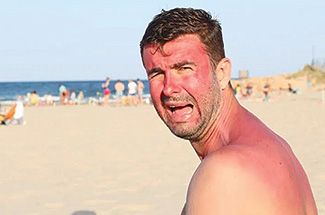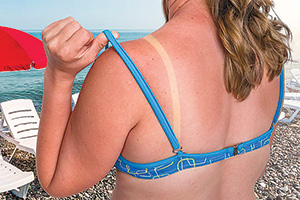 Summer is here! Clean the pool, get out the lawn darts and fill up the cooler with your favorite adult beverage. It’s time to get out of the house.
Summer is here! Clean the pool, get out the lawn darts and fill up the cooler with your favorite adult beverage. It’s time to get out of the house.
That means outings to the lake, swimming in the pool and red, hot skin that may be painful to the touch. Almost everyone at some point has experienced the pain associated with a sunburn. Despite increasing use of protective behaviors, it is estimated that at least half of all adults in the United States experience sunburn yearly, and almost two-thirds of those will experience more than one episode in the same year.
HIGHER CANCER RISK
Sunburns carry with it an increased risk of developing skin cancer, the most common form of cancer in the U.S. Most of these are non-melanoma skin cancers such as basal and squamous cell carcinomas, but the risk of melanoma is present. Sunburn at any age is associated with an increased risk for skin cancer, but the more sunburns a person experiences, the greater the risk; experiencing five or more blistering sunburns between the ages of 15 and 20 years increases an individual’s risk of developing non-melanoma skin cancer by 68 percent and melanoma by 80 percent.
UV RADIATION AND SUNSCREEN
Sunlight is a continuous spectrum of electromagnetic radiation. There are two types of UV rays – UVA and UVB – both of which can harm your skin.
UVA rays penetrate deep into the layers of the skin and leads to premature signs of aging, which include fine lines and wrinkles.
UVB rays are the primary cause of sunburn, because they penetrate the outer layer of skin and cause damage to skin cells. Too much exposure from either UVA or UVB rays can play a part in causing skin cancer.
It’s important to use sunscreen protection year-round, because the amount of UVA stays relatively constant throughout the year, and also exceeds the amount of UVB rays in both summer and winter. Even on a cloudy day, 80 percent of the sun’s UVA rays may pass through clouds. What’s more, when it comes to tanning beds, it’s important to know that tanning beds work by emitting primarily UVA rays, which penetrate deep into the skin.
UVB radiation has a greater intensity in the summer than in the winter and is at its strongest between the hours of 10 a.m. and 4 p.m.
One way individuals can protect themselves from the damaging effects of the sun is to use sunscreen. These products absorb, scatter, and/or reflect UV radiation to help prevent damage from the sun’s harmful UV rays. Sunscreens can be classified into two categories: physical and chemical. Physical sunscreens contain inorganic compounds that reflect and scatter the UV rays, whereas chemical sunscreens contain organic compounds that absorb the rays, preventing them from damaging the skin.
ALL ABOUT SPF
A sunscreen’s effectiveness is represented by its SPF. Many people think that a sunscreen’s SPF is related to the duration of UV exposure, allowing them to stay out twice as long in the sun. This is not true because this number represents the amount of UVB radiation needed to produce a sunburn on protected skin compared to unprotected skin.
There are other factors that impact the amount of solar energy. The intensity of UVB radiation plays a role in determining the amount; time of day, geographic location, and weather conditions all influence the intensity of UVB radiation. It generally takes less time during midday to be exposed to the same amount of radiation compared to early morning or late afternoon. Other factors include skin type, amount of sunscreen applied, and reapplication frequency. SPF is a relative measure and a good comparison of how well a sunscreen protects against sunburn; a product with an SPF 30 provides better protection than a product with an SPF 10.
But doubling the SPF does not provide double the protection. A sunscreen with an SPF of 15 filters approximately 93 percent of UVB rays, while a product with an SPF of 30 filters about 97 percent. Raising the SPF to 50 provides an additional 1 percent coverage, blocking 98 percent of UVB rays. There are currently no scientific data to support the use of a product with an SPF higher than 50.
BROAD SPECTRUM SUNSCREENS
A sunscreen’s SPF only indicates its ability to block UVB rays. Too much exposure to UVB rays results in a sunburn. Because UVA rays do not cause sunburn, effective blockage cannot be determined by SPF. The term broad spectrum is used to describe sunscreens that block both UVA and UVB rays. These products must pass the FDA’s broad-spectrum test procedure and possess an SPF value of at least 15 if they are claiming to reduce the risk of skin cancer and early skin aging. If they have an SPF with a value less than 15, they can only claim to help prevent sunburn.
When exposed to water, a sunscreen’s effectiveness is decreased. Those who swim or are active outdoors will need a sunscreen that will protect them during these times. The term “water resistant” is used to describe those sunscreens that will remain effective at the stated SPF level after 40 minutes in the water. Sunscreens labeled as “very water resistant” are those that remain effective after 80 minutes of swimming or intense sweating. Sunscreen should be reapplied after 40 to 80 minutes after swimming or sweating, or immediately after towel-drying.
Got burned? Here’s what to do
If you’re not careful, you could get burned. If not by the charcoal grill, then by all that July 4 sunshine. It can take several hours for the full damage to show itself. So, at the first sign, get out of the sun and follow this expert advice from the Skin Cancer Foundation.
Here’s a checklist for dealing with bad sunburn. More importantly, you should not let it happen again. Your risk for melanoma doubles if you’ve had more than five sunburns.
1. Act fast to cool it down. If you’re near a cold pool, lake or ocean, take a quick dip to cool your skin, but only for a few seconds so you don’t prolong your exposure. Then cover up and get out of the sun immediately. Continue to cool the burn with cold compresses. You can use ice to make ice water for a cold compress, but don’t apply ice directly to the sunburn. Or take a cool shower or bath, but not for too long, which can be drying, and avoid harsh soap, which might irritate the skin even more.
2. Moisturize while skin is damp. While skin is still damp, use a gentle moisturizing lotion (but not petroleum or oil-based ointments, which may trap the heat and make the burn worse). Repeat to keep burned or peeling skin moist over the next few days.
3. Decrease the inflammation. At the first sign of sunburn, taking a nonsteroidal anti-inflammatory drug  (NSAID), such as ibuprofen, naproxen or aspirin, can help with discomfort and inflammation. You can continue with the NSAIDs as directed till the burn feels better. You can also use a one percent over-the-counter cortisone cream as directed for a few days to help calm redness and swelling. Aloe vera may also soothe mild burns and is generally considered safe. Wear loose, soft, breathable clothing to avoid further skin irritation, and stay out of the sun.
(NSAID), such as ibuprofen, naproxen or aspirin, can help with discomfort and inflammation. You can continue with the NSAIDs as directed till the burn feels better. You can also use a one percent over-the-counter cortisone cream as directed for a few days to help calm redness and swelling. Aloe vera may also soothe mild burns and is generally considered safe. Wear loose, soft, breathable clothing to avoid further skin irritation, and stay out of the sun.
4. Replenish your fluids. Burns draw fluid to the skin’s surface and away from the rest of the body, so you may become dehydrated. It’s important to rehydrate by drinking extra liquids, including water and sports drinks that help to replenish electrolytes, immediately and while your skin heals.
5. See a doctor if… You should seek medical help if you or a child has severe blistering over a large portion of the body, has a fever and chills, or is woozy or confused. Don’t scratch or pop blisters, which can lead to infection. Signs of infection include red streaks or oozing pus.
Bottom line: Your skin will heal, but real damage has been done. Repeat sunburns put you at a substantial risk for skin cancer and premature skin aging. Review the guidelines in The Skin Cancer Foundation’s Prevention Handbook at skincancer.org/prevention/graphics/handbook.

